Menu
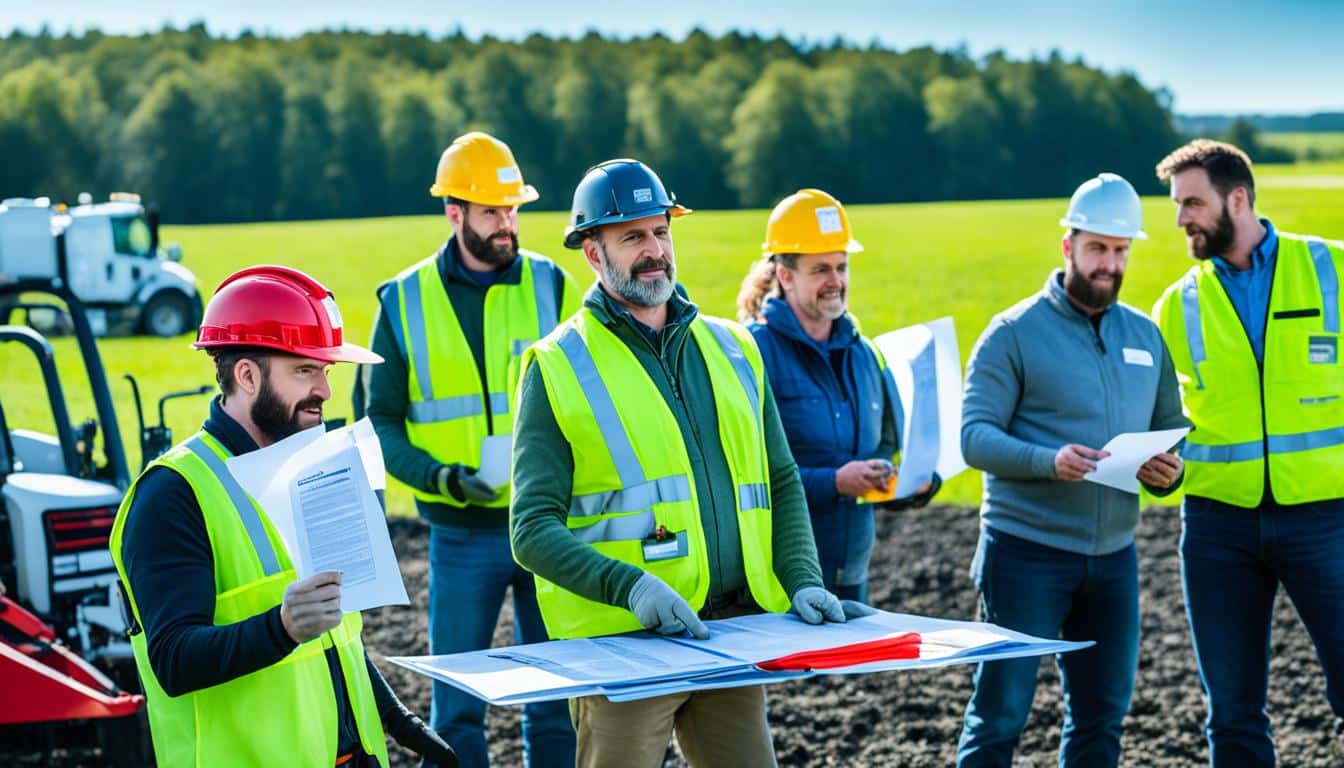
Did you know that agriculture sees a big share of workplace accidents and deaths? The U.S. Department of Agriculture’s SAY project’s data highlights the urgent need for safety rules.
Starting a farm safety and emergency committee is a smart move. It can greatly lower the dangers on a farm. Indiana PREPared stresses the need for an emergency plan. This plan is for dealing with accidents or natural disasters. It aims to protect those on the farm, including family, workers, and even first responders. Such a plan not only tackles emergencies but also keeps important information safe and ready to use.
The SAY National Clearinghouse provides essential materials. These align with Career Cluster Content Standards in Agriculture, Food, and Natural Resources. They help teach farm families good safety measures. For example, the Purdue Extension – Parke County template is a great place to start planning. It’s important to get the whole farm family and staff involved. Sharing the final plan with local help means everyone knows what to do in an emergency.
Farming is built on tradition but is always changing with new methods and tools. It’s crucial to keep safety in mind as things evolve. Following rural health and safety guidelines keeps everyone safe on the farm.
Accident stats show why we need to focus on keeping farms safe. For example, the PTO (Power Take-Off) is very dangerous. Tractors and machinery are risky, especially on roads, causing many accidents each year.
If kids are under 12, they shouldn’t ride ATVs above 70 cc because they’re not safe. Also, old tractors might not have safety features, which is dangerous. Making sure you use the latest safety gear is key in the agriculture sector.
Farm safety affects everything on the farm. Working near grain bins can be fatal if not done carefully. But, farming can be safer if you follow rural health and safety guidelines closely. Accidents can cost a lot and hurt the farm’s success.
It’s also vital to understand how to be safe around cattle. By using good prevention methods, farms can keep their people and their business safe. This creates a work environment that’s both secure and productive.
Farms have many risks. These need careful thought and handling. The farm hazard identification checklist is key for farm safety. It helps spot dangers early and lessens their harm.
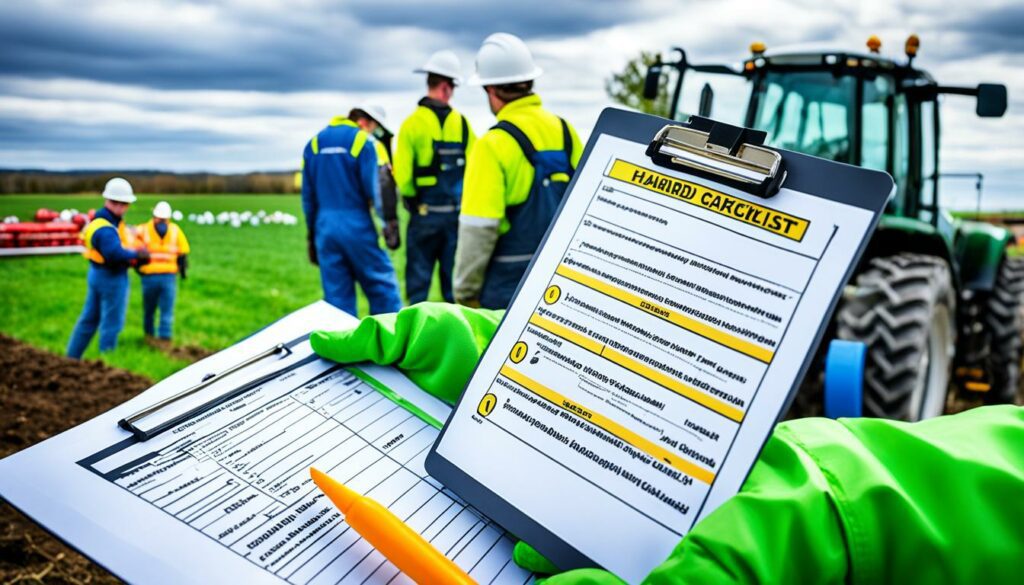
Working on a farm means facing several dangers. These can cause health problems like breathing issues and skin trouble. They also up the risk for certain cancers, chemical poisoning, and heat issues. Using a good hazard checklist is vital to stay safe.
Loud noises are a big worry on farms. Farm machines and chores can be much louder than safe levels. If you have to shout to be heard a meter away, the noise could hurt your ears. Always wear effective ear protection like muffs and plugs, especially if they have a high SLC 80 rating.
| Noise Source | Decibel Level |
|---|---|
| Tractor | 95-100 dB(A) |
| Chainsaw | 105-120 dB(A) |
| Pig Shed at Feed Time | 95-105 dB(A) |
Stress is another big issue on farms. It can harm health, relationships, and how well you work. It’s important to manage stress by finding its causes, solving issues bit by bit, taking some time off, and relaxing. This is a key part of the farm hazard identification checklist.
Weather dangers are common on farms too. High temperatures, moist air, and hard work can lead to heat stress. To prevent this, use fans, find shade, and drink plenty of water. Start with lighter work and increase slowly.
More hands managing farm risks leads to less harm. It’s not just about avoiding injuries but also staying healthy. Everyone on the farm, from bosses to workers, should focus on safety.
Setting up *on-farm emergency response procedures* is crucial for dealing with incidents well. It starts by making a strong committee. This group will look after how safety and emergency plans are done and followed. They make sure everyone knows what to do.
The committee tells each member what they should do. They train farm workers to know their jobs during emergencies. It’s important to make sure the emergency plans are carried out well.
The right farm safety team should have people from everywhere on the farm. This means folks from the family, workers, and emergency responders nearby. Working together, especially with firefighters and medics, helps a lot in emergencies.
It’s key to get the whole farm community to know about *on-farm emergency response procedures*. Doing regular practices and learning sessions gets everyone ready. Plus, getting a break on insurance premiums is good encouragement.
A good committee does more than just quick emergency responses. They also help with learning about safety all the time and meeting safety rules. For example, the Farm Safety Partnership Advisory Committee (FSPAC) does a great job by pulling together different parts of the industry to improve safety at work. The FSPAC has a plan that looks at important safety issues. Other local farm safety groups can learn from them.
| Safety Focus Area | Key Objectives |
|---|---|
| Behavior, Education, and Training | Improving safety awareness and practices. |
| Health and Vulnerable Persons | Protecting the health and safety of all farm workers. |
| Tractor and High-Risk Machinery | Reducing machinery-related incidents. |
| Livestock Handling | Ensuring safe animal handling practices. |
| Buildings and Work at Height | Preventing injuries from falls and structural failures. |
By following *on-farm emergency response procedures*, farms can lower risks. This makes sure everyone is ready for emergencies. It protects both people and their jobs.
Every farm must have clear health and safety guidelines. Agriculture is very risky, making policies vital. Farmers and ranchers deal with many dangers. So, it’s key to have rules that can reduce these risks.
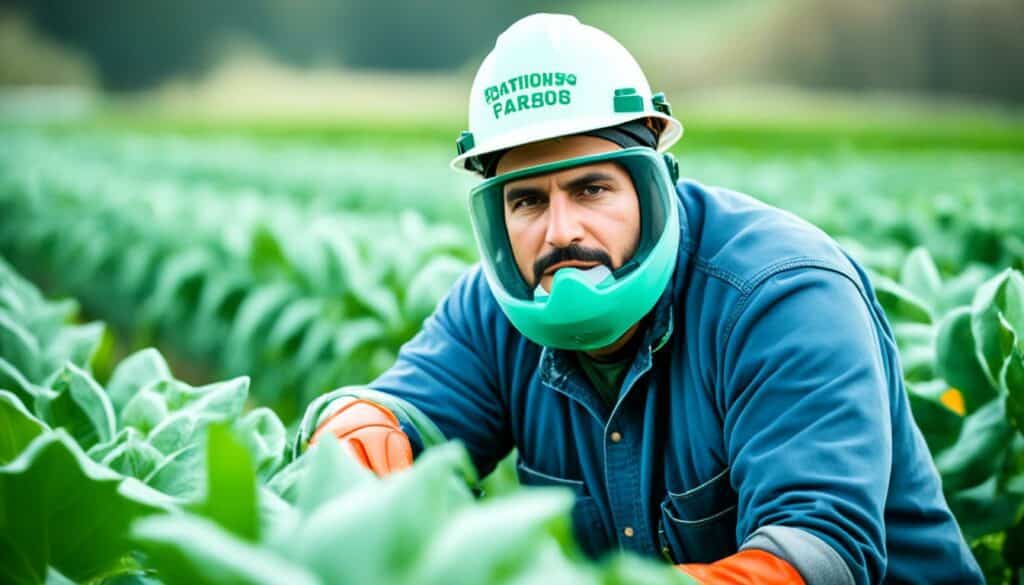
New farmers within their first ten years are more at risk of getting hurt. That’s why having a written safety plan is crucial. This plan should explain the safety rules and what to do in emergencies. It helps everyone on the farm, including the family and workers, know how to stay safe.
Employers need to follow the rules of the Occupational Health and Safety Act. This act has rules for farms of all sizes, like how to keep workers safe. It also says what to do depending on how many people work on the farm:
Just having safety rules is not enough. Everyone on the farm needs to know them well. They should learn about the risks and how to stay safe. Using safety training helps make sure everyone knows the rules and follows them.
WCB Nova Scotia provides insurance for workplace injuries in Nova Scotia. It’s a must for farm owners. This insurance helps if a worker gets hurt. It pays for lost wages and medical fees, making sure workers are looked after.
Good safety also includes regular safety talks, using posters, and checking procedures often. Farms need to keep up with better safety tools and add them to their safety plans.
Summing up, making and following farm safety policies is all about keeping rural areas safe to work and live. It’s using safety training and rules to make farms a safe place for everyone.
Having on-farm emergency plans is key for quick and efficient action in emergencies. A good plan can reduce harm, save lives, and lower costs. It can also help farms improve safety and get discounts on insurance.
Key to any emergency plan is easy access to contact details. Include numbers for fire brigades, medics, and crisis teams. These must be visible all over the farm. Indiana PREPared points out that no farm is safe from emergencies, making these steps critical.
Quickly dealing with fires and medical issues is crucial. Plans must have clear steps prepared. Hold fire drills and first aid training for staff and family. It’s also crucial to have clear escape plans for people and animals, updated regularly based on experiences.
Strong emergency plans mix contact lists with practical actions. Using resources like Purdue’s Code Red and working with local responders helps. This way, farms protect their most important resources – their people.
| Component | Action Steps |
|---|---|
| Emergency Contact Information | Display in centralised locations; update regularly. |
| Fire Drills | Conduct routine drills; ensure all personnel are trained. |
| First Aid Training | Provide comprehensive first aid courses for staff. |
| Evacuation Routes | Map and mark routes; conduct evacuation drills. |
I’m a big promoter of farm safety. Our goal? Making sure farm families know how to handle emergencies and reduce risks. We offer many educational programs tailored to meet the needs of farmers.
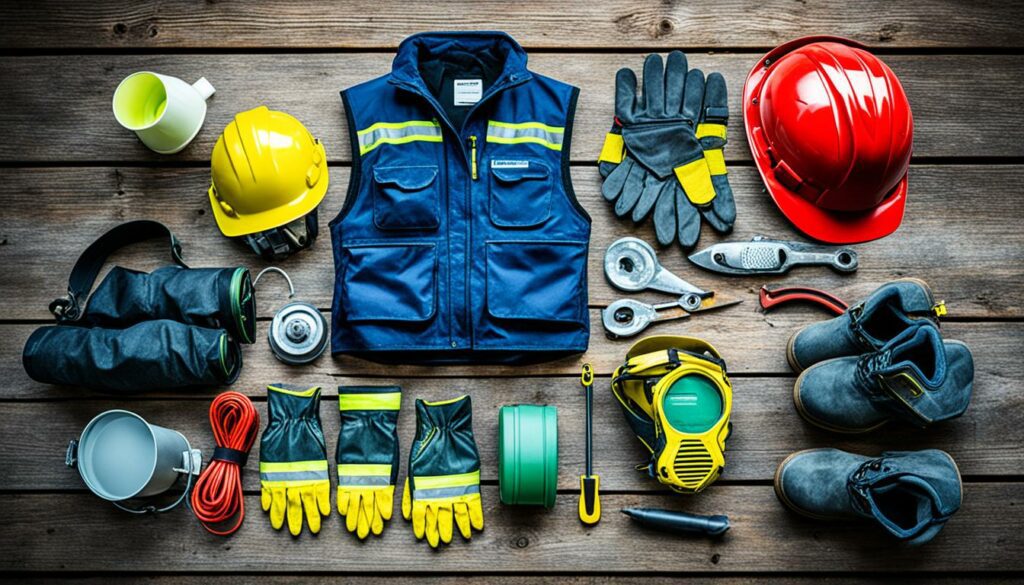
Our work includes training on the dangers of Power Take-Off (PTO) equipment. PTOs are major risk areas on farms, needing detailed training. We also talk a lot about adding Roll Over Protection Structures (ROPS) to old tractors. Even though it costs money, the safety it brings is worth it.
Our focus isn’t just on big machines. We also teach about ATVs, especially for young users. Kids under 12 shouldn’t ride big ATVs, and under 16s should avoid adult ATVs. Wearing helmets and no passengers on ATVs are also big rules for us.
Grain handling dangers are a major topic too. Entering grain bins can be deadly. Using safety systems like lifelines and lock-out/tag-out practices can save lives.
Knowing how to deal with animals is another key area. We teach about cattle behaviour and how to stay safe when working with them. It’s all about planning and handling livestock correctly to prevent accidents.
Transporting equipment can be risky. We warn about the dangers of driving tractors on public roads. Following basic safety rules is a must to avoid accidents.
Emergency preparedness is also critical. We focus on preparing the farm community for security emergencies. This involves building plans and partnerships with local emergency services.
Overall, we’re dedicated to offering top-notch farm safety training resources. Our programmes aim to make safety, readiness, and strength part of farm culture.
Adding safety into farm management is key to work safely in agriculture. Farming is highly risky, so having good accident prevention plans is a must. By making safety a part of the plan, everyday work is safer. This also lowers the chances of facing legal and money problems.
New farmers, especially those with under ten years of experience, meet a lot of dangers. It’s vital for them to have a written safety plan. This plan talks about how to stay safe at work. It helps new farmers and ranchers lower risks by fitting safety into their business plans.
Dick Wittman’s Process Improvement Audit Checklist helps farmers check their safety efforts. It points out where safety can be better. Things like training and safety checks are also big helps. They make sure everyone on the farm knows how to stay safe. These steps create a work environment focused on safety. They stress the importance of working safely in farming and strengthen accident prevention.
Knowing the dangers on a farm is crucial. Material shows that agriculture is deemed one of the riskiest jobs in the U.S. This means the people who work in farms face many dangers every day. It shows why having a detailed farm hazard identification checklist is so important.
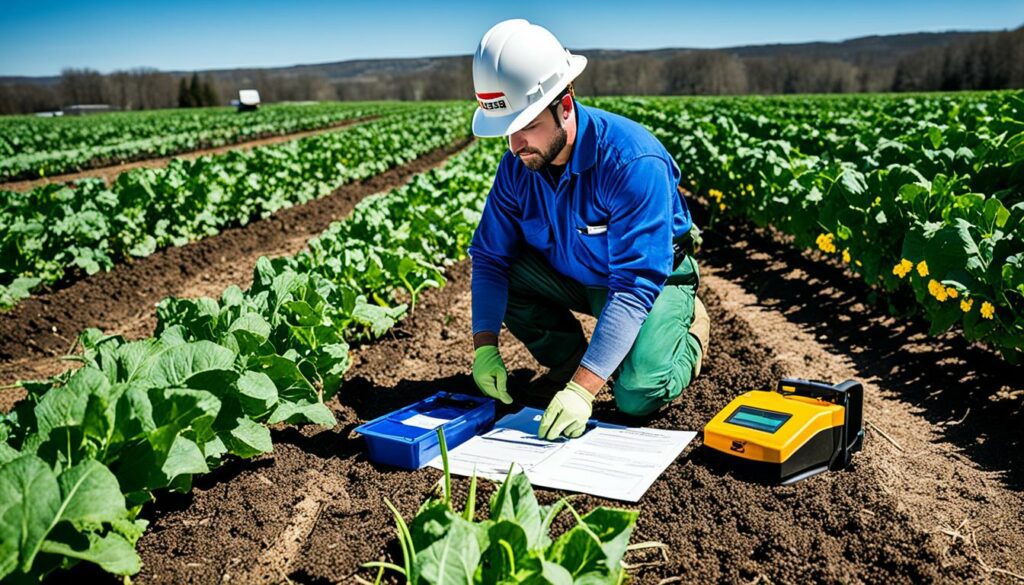
New farmers often face more risks. They might not know all the dangers of working with equipment, animals, and the environment. To help them stay safe, a manual is available. This guide gives them the knowledge they need to reduce risks and be safe.
This manual has five parts. It offers advice on how to be safe and healthy in farming. It is key for farm owners to have a plan for health and safety. This plan should have important parts, like safety rules and procedures.
In Nova Scotia, there are laws to keep workers safe. Everyone must follow these laws to make sure they are working in a safe way. The Farm Safety Plan checklist helps cover the important safety aspects for farms.
Workers can learn online for free. They can also join workshops online or in person. The Passport to Safety document tracks their training. If workers need more help, they can email or call a Farm Safety Advisor.
By carefully making and updating a farm hazard identification checklist, farmers can make their work safer. This helps lower risks for everyone on the farm. Planning for safety in advance is crucial for a safe farm.
Preparing for emergencies is vital for farmers. It keeps family, staff, and first responders safe. A good emergency plan helps reduce risks on the farm.
Every farm member should help make the emergency plan. This makes everyone know what to do. Indiana PREPared advises thinking about all kinds of emergencies. A good plan can prevent harm and even save lives.
A template from Purdue Extension – Parke County can help start your plan. Having important papers and info ready is key for a quick recovery. Make sure to check your farm for any hazards to act early.
When farms have an emergency plan, they might get insurance discounts. This is an extra reason to plan well for an emergency.
Emergency plans need to be updated often. Everyone on the farm should practice what to do. This keeps you ready if disaster strikes.
It’s important to work with local emergency services. They can help make sure your plan fits with theirs. Sharing knowledge through educational slides can also help.
Give your team a list of important contacts. This should include farm owners, vets, and state officials. Using good practices like backup power and clear alarm systems makes your plan better.
| Best Practices | Details |
|---|---|
| Employee Training Programs | Regular training on roles during emergencies |
| Backup Power | Ensuring operational continuity during power outages |
| Emergency Releases | Protocols for gates, pens, and barns |
| Insurance on Buildings and Cattle | Protects assets and provides peace of mind |
Farm safety is critical and needs many resources to succeed. There are plenty of online tools to help provide safety training. They are free and come in English and Spanish, so everyone can use them.
For effective safety training, use these online tools and templates:
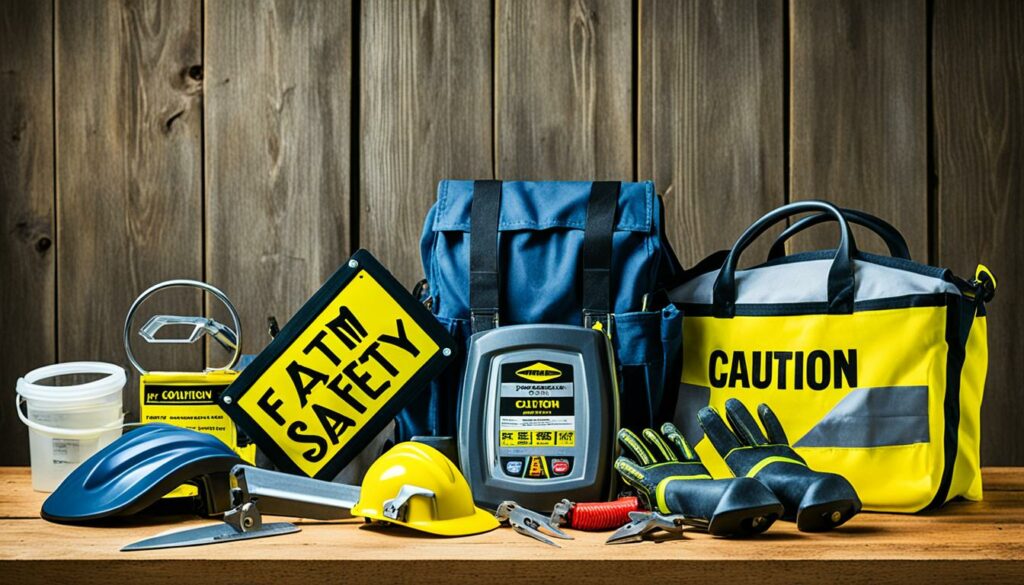
NYCAMH offers good deals on respirators and protective gear. This helps with risky jobs like handling chemicals or working near silos. They also run a program to check that respirators fit well, further ensuring worker safety.
There’s also the Farm Emergency Response Program. It teaches fire safety, first aid, and more. This program is crucial, particularly for training on dangers of manure pits. Over 150 people have benefited, including farmers and emergency teams.
The USDA’s SAY Project is making a big difference with farm safety for young people. It runs until 2025. The project includes lessons, videos, and support for teachers. Topics cover grain safety and understanding dangers in livestock farming, plus more. They also publish eNews and reports since 2015.
Here are some important resources:
| Resource | Description | Availability |
|---|---|---|
| On-Farm Safety Training | Covering specific safety aspects for different farm types | No cost; available in English and Spanish |
| Agribusiness Presentations | Various health and safety topics | No cost |
| Youth Farm Safety Activities | 4-H clubs and high school agriculture classes | No cost |
| Emergency Response Training | Fire safety, preparedness, first aid, CPR | No cost; available in English and Spanish |
| Respirator Fit Testing Program | Ensuring proper respiratory protection | Available |
| Grain Bin Safety Week | Highlighting grain bin safety importance | Annually, February 18 to 24 |
| SAY Project | Youth farm safety curricula and resources | Ongoing (2021 – 2025) |
These resources, including tools and templates, are vital for farm safety. By using them, farmers can make their workplaces much safer for everyone involved.
Farm emergency planning should involve local services for better response. It’s key to work together with fire departments, EMS, and law enforcement. They can help create better plans and respond faster in times of need.
Local fire departments are critical in farm emergency planning. They should know the layout and risks of the farm. This way, when there’s an emergency, they can act quickly and safely. A report by the USAHA mentions this is crucial for fighting diseases. So, working closely with fire services is a must.
EMS and police also need to be part of the emergency plan. They handle medical issues and enforce laws. Regular meetings and shared training make responses better and faster. This is backed by conclusions from a survey on bioterrorism preparedness. Therefore, working closely with these groups adds strength to the plan.
Looking at past outbreaks, like the West Nile virus, shows us we need a united front. By involving local services early on, farmers are better prepared for any emergency. In the end, working together is the best way to keep farms safe.
| Key Aspect | Importance | Source |
|---|---|---|
| Engaging Fire Departments | Improves rapid response and knowledge of specific farm hazards | USAHA Gray Book |
| Involving EMS and Law Enforcement | Enhances medical and law enforcement response times and effectiveness | Survey by Fitzpatrick AM and Bender JB |
| Past Incident Lessons | Informs on the necessity of coordinated response systems | West Nile outbreak study by Fine A and Layton M |
Keeping the farm safe means following important laws on workplace safety. The Occupational Health and Safety Act (OSHA) is key here. It’s made just for farming, ensuring the work is safe and meets health standards. It’s vital for farmers to know federal and state safety rules. This helps them create safety plans that follow the law.
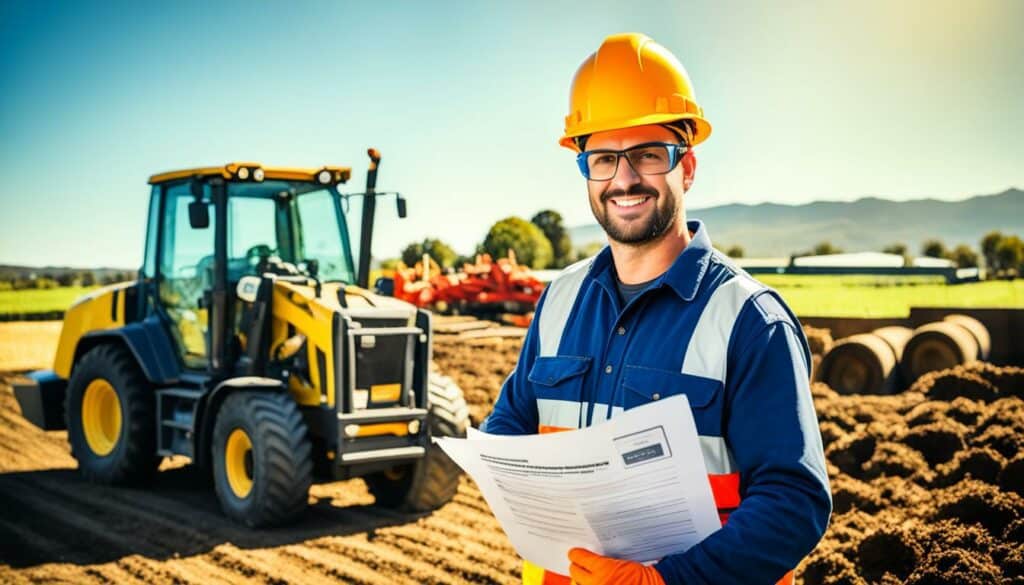
The Occupational Health and Safety Act sets certain rules for farms. For instance, it says slow-moving vehicles need a special emblem if they go under 25 mph. It also talks about tractor safety, requiring protection if they’re over 20 horsepower and made after October 1976. Sticking to these rules is a must to keep workers safe. Also, employers need to keep a close record of any injuries. It’s not just a rule; it’s key to good safety management.
Insurance, like workers’ compensation, helps protect everyone on the farm. Knowing about workers’ compensation is crucial, as it varies from state to state. It makes sure that if someone gets hurt at work, they’re covered for medical care and get money while they can’t work. For farm owners, it helps them cover the costs of work injuries. This keeps the farm running smoothly.
| Key Aspect | Details |
|---|---|
| Vehicle Safety | Slow-moving vehicle emblems, rollover protection for tractors |
| Record Keeping | Required for farms employing over 10 workers |
| Insurance Coverage | Workers’ compensation, private insurance options |
| Legal Compliance | Adherence to federal and state-specific occupational health standards |
By focusing on law, farms can be safer places. Being proactive reduces the chances of accidents. It also builds a safe culture on the farm. Regular checks on safety rules and updates are wise. This makes sure the farm keeps up with any new safety laws.
Being ready for emergencies is key for those in farming. Safety plans should be a big part of how we do business.
It’s important to find and manage risks. This lets us create good ways to deal with possible problems. Making sure all workers know what to do keeps the farm safe.
Always looking out for new risks is crucial. We must update training often to share the latest safety tips. Rechecking safety plans ensures they still work well.
Many help programs focus on farm emergencies. For instance, the Livestock Forage Disaster Program (LFP) and the Livestock Indemnity Program (LIP) help when bad weather or illness hurts the farm. These can really help in tough times.
The Emergency Assistance for Livestock, Honeybees, and Farm-Raised Fish (ELAP) gives aid for different losses, from disease to big storms. And the Emergency Loan Program supports farmers hit by natural problems.
The Emergency Conservation Program (ECP) fixes damaged farmland. For losses not covered by insurance, the Noninsured Disaster Assistance Program (NAP) offers help. The Tree Assistance Program (TAP) assists in replanting after disasters for tree growers.
Preparation is seen in the Emergency Livestock Relief Program (ELRP). In Texas, special help was given during wildfires. Plus, the Texas Department of Agriculture offers support in critical times.
Recognising and acting on the need for emergency readiness is essential for farmers. It helps protect the farm and all its important assets.
As we near the end, it’s clear that having a farm safety and emergency team is crucial. It goes beyond just following rules or acting in crises. It’s about protecting the lives and health of everyone on the farm. And it helps keep the farm strong and ready for the future.
This vital role is backed by a new legislative plan worth $1.5 trillion. The “Farm, Food, and National Security Act of 2024” shows a serious commitment. It offers more money for rural growth and beginner farmers. It also ups support for programs like the Specialty Crop Block Grant and Farm Bill conservation. This helps secure the future sustainability of farms.
Also, the Act pays attention to food insecurity through SNAP. It helps over 41 million people in low-income areas. And it changes rules to help active military members. Funding for improving rural areas and handling water and waste issues is a big step forward too. It all shows a full approach to managing risks in agriculture.
In agriculture, danger is real, even more than mining and quarrying. So, having strong safety plans is not just useful but essential for farming success. These plans can cut down on farming’s high injury rate. A good farm safety and emergency team builds more than just readiness. It creates a culture of care, effectiveness, and eco-friendly farming for the future.
Developing this committee is key for preparing for emergencies on the farm. It helps farmers manage risks better. This way, they can make sure that everyone knows how to stay safe and react in an emergency.
Farm safety is vital for everyone on the farm. This includes workers, family, and visitors. Following health and safety guidelines and preventing accidents help keep the farm a safe place to work.
Use a checklist to spot risks like machinery, animals, and chemicals. Understanding these dangers is the first step to prevent accidents.
To set up the committee, define who does what clearly. Make sure there’s a mix of people on it and that everyone on the farm is involved. Working together is crucial for a strong response team.
These policies should tell everyone how to stay safe. They must cover what to do in emergencies and include training. Making sure everyone knows and follows these rules is very important.
Have a list of emergency contacts ready. Know what to do in common emergencies like fires. Make sure all farm workers can easily understand and follow the emergency plan.
By offering safety resources and training, these programs improve daily safety practices. They ensure everyone is ready for any emergency on the farm.
To manage safety, weave it into your farm’s daily planning. Regularly check for risks, update safety training, and use strategies to avoid accidents. This keeps the farm a safe place to work.
This checklist helps find and fix farm dangers before they cause harm. Taking a proactive approach keeps the farm safe and accident-free.
A good emergency plan involves everyone and clearly explains what to do in a crisis. It needs to be checked and updated regularly to make sure it works when needed.
There are many tools online for safety training, like handbooks and risk assessment forms. These resources make it easier to train your farm staff and keep safety practices up to date.
To work with first responders, talk to the fire and police. Showing them your plans helps them react faster and better in an emergency.
Know the health and safety laws to look after your employees right. Getting the right insurance and compensation also protects your farm and workers.
Keep your farm ready by making safety part of your daily routine. Regular training and knowing the newest safety info are key. This helps keep everyone safe on the farm.